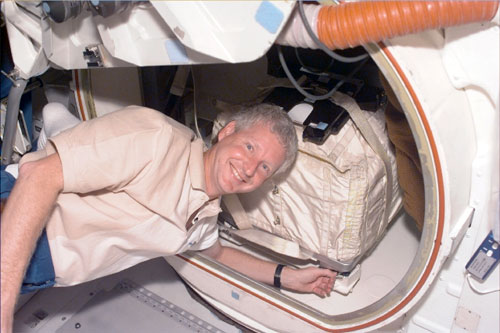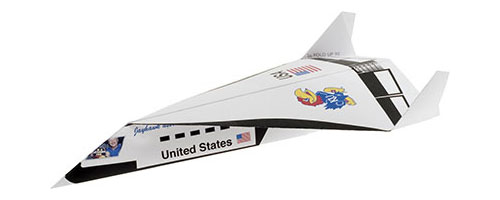Astronaut Steve Hawley is coming home to Planet Jayhawk.
University of Kansas Chancellor Robert Hemenway announced today that Hawley, a Salina native and 1973 KU graduate in physics and astronomy, will join the university faculty this fall to teach and to promote education in science and math.

Hemenway and Hawley, one of three astronauts from Kansas, are making the announcement in a series of press events today at Salina Central High School, from which Hawley graduated in 1969; the Kansas Cosmosphere and Space Center in Hutchinson; the Statehouse in Topeka; and the Dole Institute of Politics on KU's Lawrence campus.
"Steve Hawley has always been generous in sharing his experiences and observations with our students and faculty over the years, so we are thrilled and gratified that he will now be doing that on a full-time basis here at KU," Hemenway said. "He will enhance an already incredibly strong physics and astronomy program, as well as be able to travel Kansas so young people statewide can be inspired and encouraged to pursue careers in science."
In Kansas, the number of teacher licenses in chemistry, biology and physics have plummeted, Hemenway noted, and many schools in the state will recruit overseas to fill more than 400 secondary teaching positions in science and mathematics this year.
"Science education is vital to the future of this state and nation," Hemenway said. "We need people like Steve to build a new excitement and urgency about science and math education."
Hawley, 56, said his new role at KU fulfills a longtime desire to return to Kansas, adding that the mission of promoting interest in science is a perfect fit.
"In my career, I have literally had the chance to see the world," Hawley said. "But today there is no place else I would rather be. It is good to be home. Working with students at KU and across Kansas is a wonderful opportunity to share what I have seen and encourage them to set high goals and go out and discover what this world has to offer."
The National Aeronautics and Space Administration selected Hawley to be an astronaut in 1978. He became the third Kansan — all of whom are KU graduates — to fly in space. His first shuttle experience, in 1984, was the maiden flight of the shuttle Discovery and involved numerous experiments and deployment of several satellites. He was a mission specialist on shuttle flights in 1986, 1990, 1997 and 1999.
During his 1990 flight aboard Discovery, the crew deployed the Hubble Space Telescope, and he returned to Hubble on the second servicing mission in 1997. During his 1999 flight, the crew deployed the Chandra X-ray Observatory — the third of NASA's space observatories. He has logged more than 32 days in space.
From 2001 to 2002, Hawley was director of Flight Crew Operations at NASA's Johnson Space Center in Houston. He is now director of astromaterials research and exploration science at NASA. In that role, Hawley oversees research in planetary and space science and is responsible for NASA's collection of astromaterials, including the moon rocks, comet dust, Martian meteorites and solar wind particles.
Hawley has received numerous honors, including Kansan of the Year in 1992; Kansas Aviation Hall of Fame induction in 1997; KU's Distinguished Service Citation in 1998; and the NASA Distinguished Service Medal in 1998 and 2000. He was recognized as a distinguished alumnus of KU's College of Liberal Arts and Sciences in 2007.
KU has a rich history in astronomy, starting with alumnus Clyde Tombaugh, who discovered Pluto on Feb. 18, 1930, and is the namesake of the campus observatory.
Other Kansas astronauts were Ron Evans, a St. Francis native who grew up in Topeka, and Joe Engle, a Chapman native. They earned aeronautical engineering degrees at KU in 1955 and 1956, respectively. Evans piloted the Apollo 17 command module that orbited the moon. Engle piloted the space shuttle Columbia in two approach and landing tests in 1977 and commanded two shuttle missions, including Columbia's second flight into space in 1981. Evans died in 1990.
KU's Department of Physics and Astronomy has 25 faculty members and offers undergraduate and graduate degree programs. Faculty research draws $3.7 million a year in external funding for studies in large scale (solar system, galaxy and universe by the astronomy, cosmology and space physics groups); small scale (nuclear, high energy and astro-particle physics groups); and bulk matter physics (condensed matter and biophysics groups). Strong interdisciplinary programs exist in biophysics, nano-bio science, accelerator physics and astrobiology.














